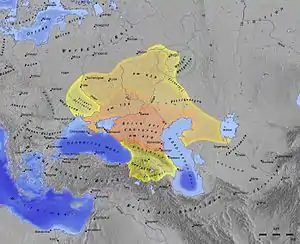Saltovo-Mayaki
Saltovo-Mayaki or Saltovo-Majaki is the name given by archaeologists to the early medieval culture of the Pontic steppe region roughly between the Don and the Dnieper Rivers, flourishing roughly between the years of 700 and 950.[1]

History
Saltovo-Mayaki influence was strong in the area of the Volyntsevo culture to the northwest of the main Saltovo-Mayaki territory. During the ninth century the Saltovo-Mayaki culture was closely associated with the Khazar Khaganate, and archaeological sites from this period are one way that historians track the geographic scope of Khazar influence.
Characteristics
The Saltovo-Mayaki material culture was "fairly uniform" across the various tribes.[2]
Ethnicity
Their culture was a melting pot of Onogur, Khazar, Pecheneg, Magyar, Alan, and Slavic influences.
Genetics
A genetic study published in Nature in May 2018 examined three males of the Saltovo-Mayaki culture buried in Belgorod Oblast, Russia between ca. 700 AD and 900 AD.[3] The sample of Y-DNA extracted belonged to haplogroup R1.[4] The three samples of mtDNA extracted belonged to the haplogroups I, J1b4 and U7a4.[5]
References
- Brook, Kevin Alan (27 September 2006). The Jews of Khazaria. Rowman & Littlefield Publishers. pp. 35–36. Retrieved 30 May 2017.
- Knauer, Elfriede R. (2001). "A Man's Caftan and Leggings from the North Caucasus of the Eighth to Tenth Century: A Genealogical Study". Metropolitan Museum Journal. The University of Chicago Press. 36: 125–154. JSTOR 1513059.
- Damgaard et al. 2018, Supplementary Table 2, Rows 106-108.
- Damgaard et al. 2018, Supplementary Table 9, Row 74.
- Damgaard et al. 2018, Supplementary Table 8, Rows 46-48.
Sources
- Damgaard, P. B.; et al. (May 9, 2018). "137 ancient human genomes from across the Eurasian steppes". Nature. Nature Research. 557 (7705): 369–373. doi:10.1038/s41586-018-0094-2. PMID 29743675. Retrieved April 11, 2020.
